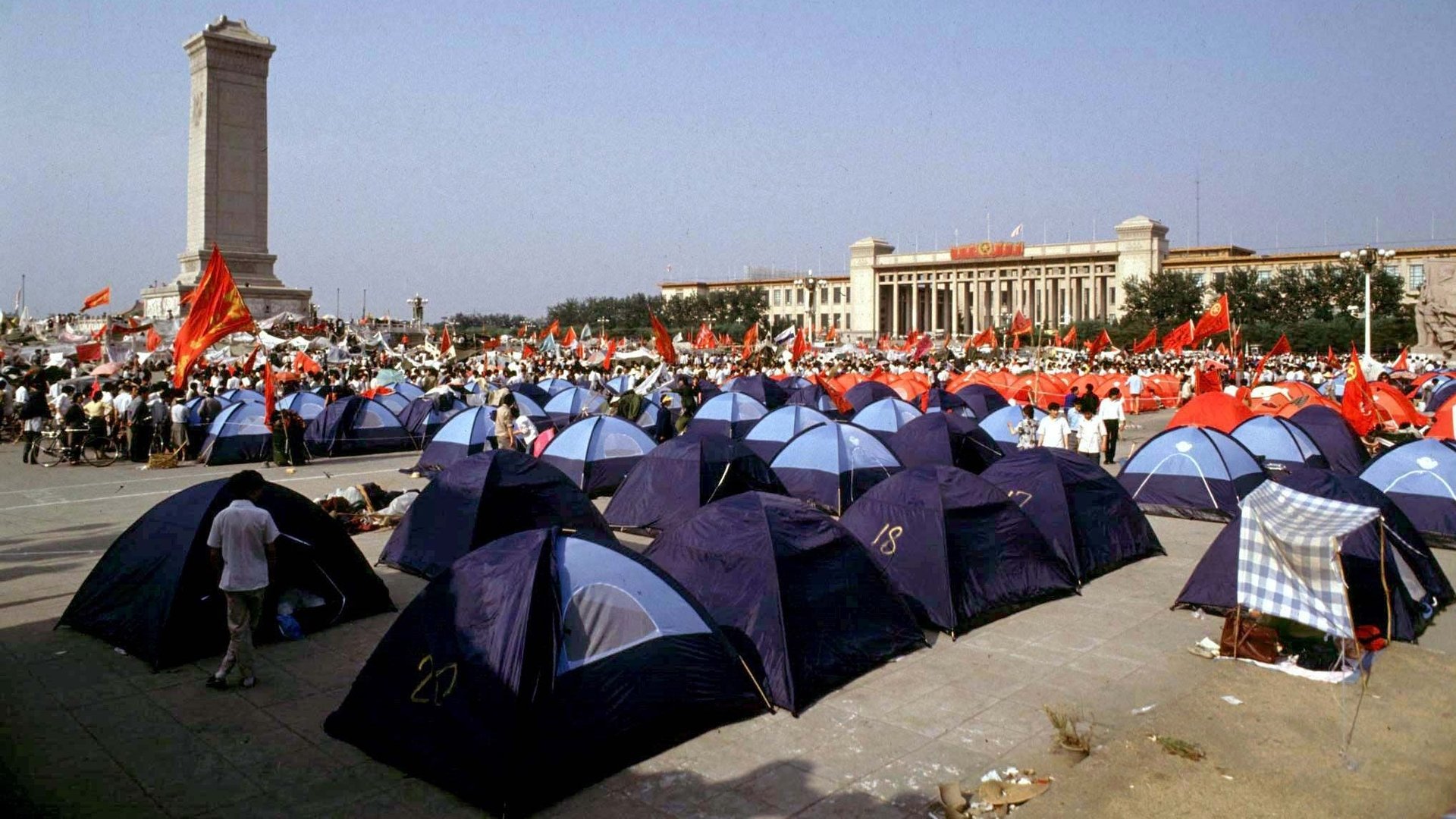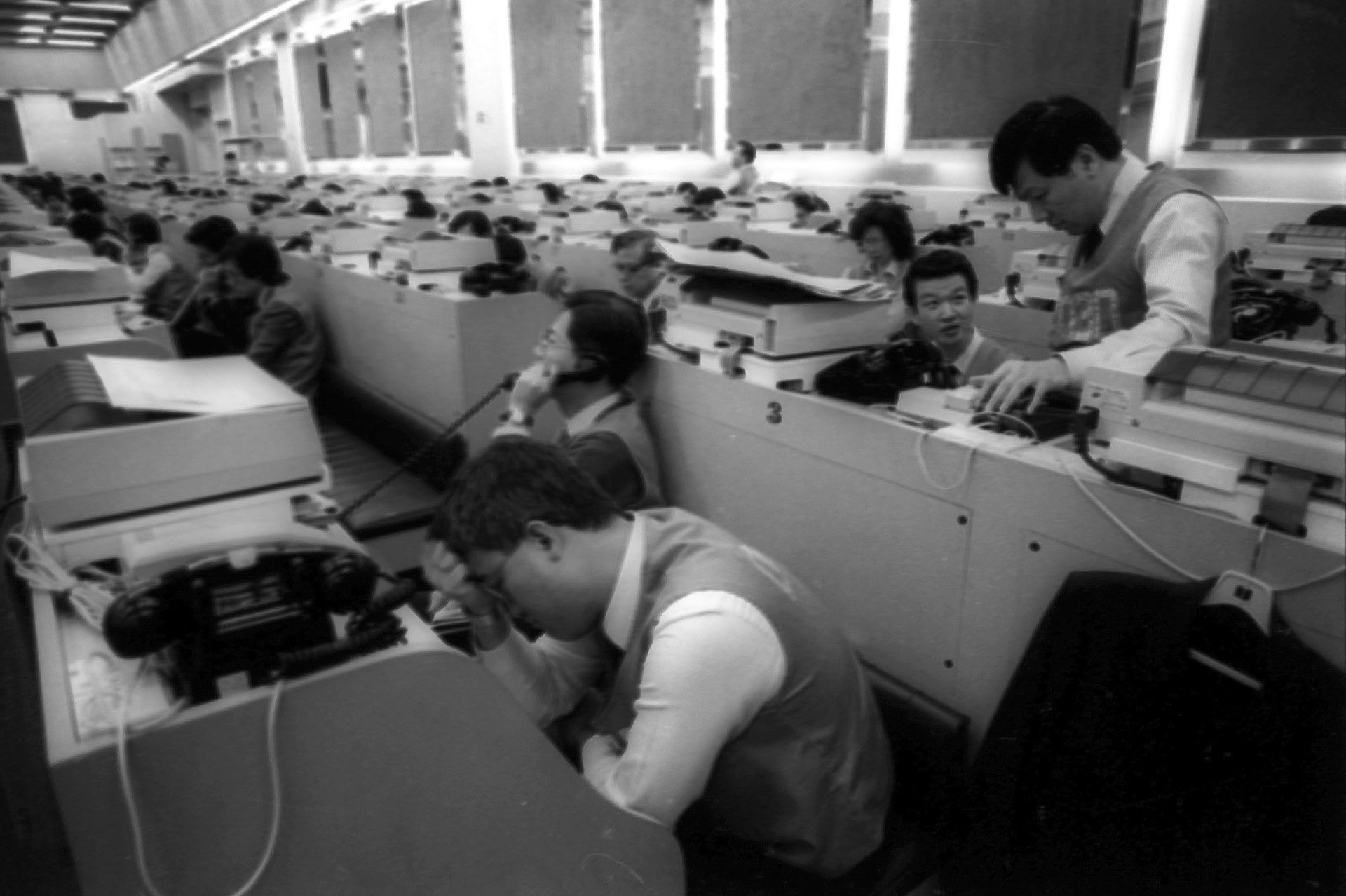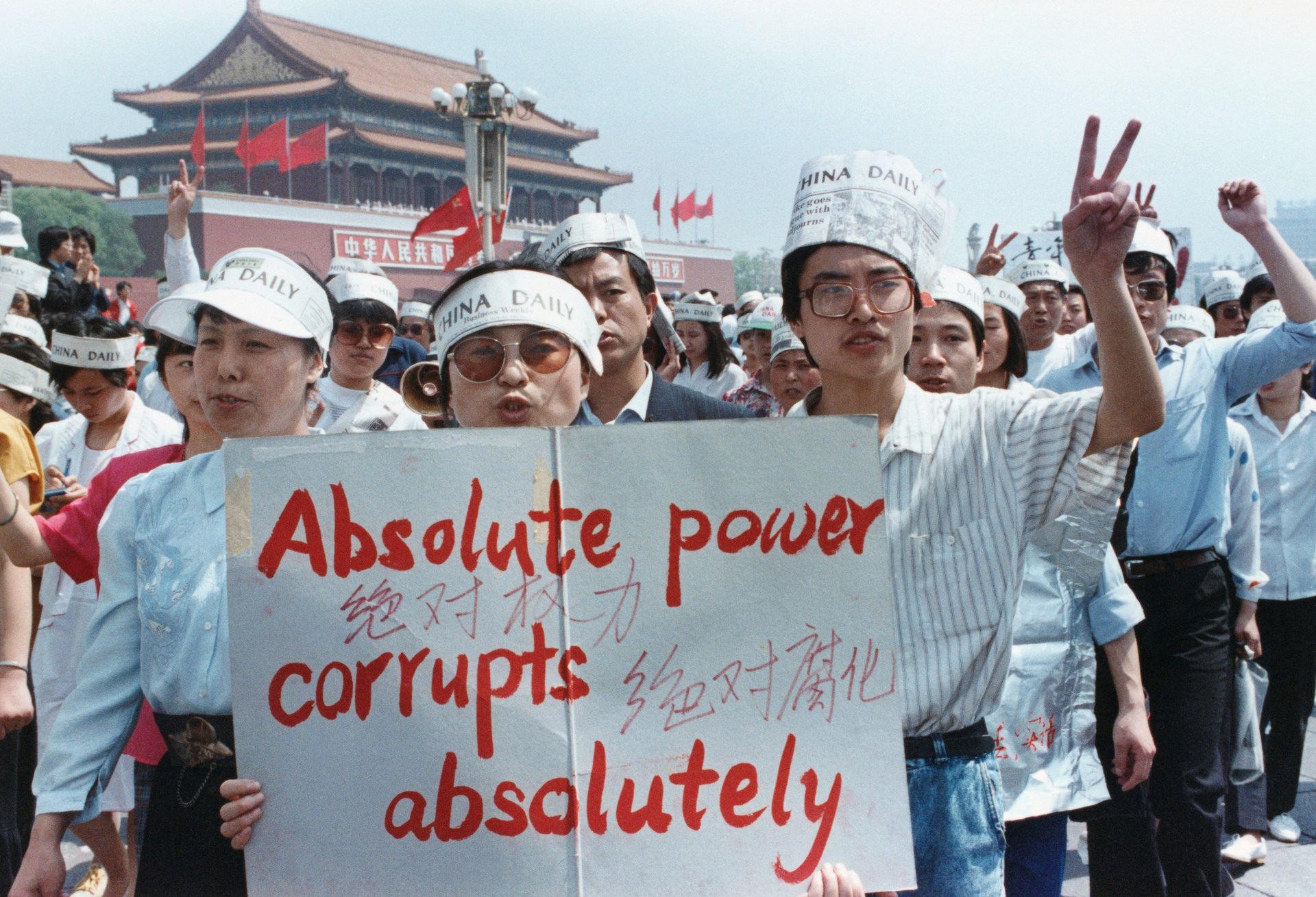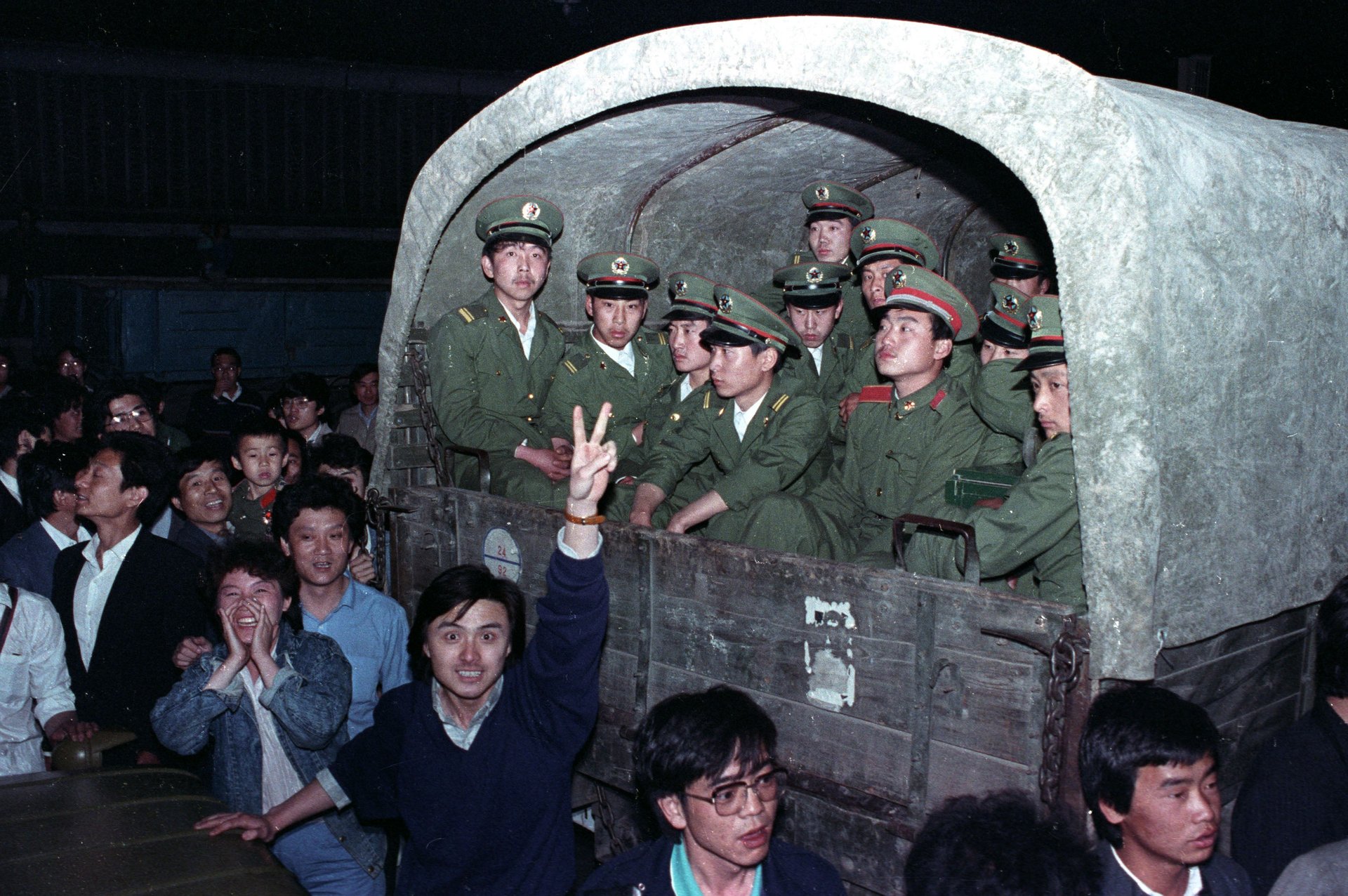The very last spring all things seemed possible in Beijing
April 15, 1989, seemed a day like any other: The sandstorms had stopped, and Beijing, pre-pollution, had daily blue skies. In the evening, you could see the stars, as the city was only moderately lit.


April 15, 1989, seemed a day like any other: The sandstorms had stopped, and Beijing, pre-pollution, had daily blue skies. In the evening, you could see the stars, as the city was only moderately lit.
A little after 10pm, I was sitting on the balcony at Beijing Normal University, where I was an exchange student. I had arrived in Beijing in August, together with my class: we were reading Chinese at the School of Oriental and African Studies in London, and our second year was to be spent at what was called, for short, BeiShiDa.
I heard unusual noises approach from the north. Along Xinjiekou Avenue, the road that went straight up toward People’s University, Peking University, and Tsinghua—among the most prestigious centers of higher learning in China—a couple hundred students were marching and chanting slogans, charging the spring evening with a momentous energy.
I rushed downstairs, into the street. One of the university administrators, who had checked in the exchange students at the beginning of the school year and whom we had very rarely seen since then, called out to me, using my Chinese name: “Lan Ruya! Don’t go out!” he shouted. I was surprised he knew me so readily. “But I must know what is going on,” I said, and slipped out of the gate just before it was locked.
More students were moving past—mostly on foot, some on their bicycles. There weren’t many cars in the city at the time, especially at night. The roads were lined with large bicycle lanes on both sides and rows of poplar trees. In April, it meant a lot of sneezes for those sensitive to pollen. Evenings in Beijing were very quiet, so being outside at close to 11pm felt really late.
A few foreign journalists arrived in front of Beijing Normal, driving up fast from the diplomatic compounds in the city center, asking what we had seen and what was happening.
Hu Yaobang, former general secretary of the Communist Party, had just died of a heart attack at 74, and the students had taken to the streets to commemorate him. He meant a lot to them: He had died in disgrace, after having been removed from office in 1987 (pdf), for having supported a pro-democracy student protest in the winter of 1986-1987. And while the party had punished him, the students called him “China’s spirit.” A large black-and-white banner featuring his portrait and the students’ description of Hu would soon be hanging from the Monument to the People’s Heroes, in Tiananmen Square, part of what became the biggest spontaneous mass movement in modern China.

It would end less than two months later, in a bloodbath, followed by months of military occupation of Beijing. The curfew was only lifted in January 1990. The political repression and heavy censorship that started then is still in place today, entrenched in daily life and much deeper and more technologically advanced under the leadership of president Xi Jinping. Tiananmen—like much of China—is under constant surveillance.
Everything surrounding those days and those protests has been forcibly erased from memory. In many ways, China hasn’t ever recovered to what it was before the crackdown, when debate and speech were as free as they have ever been under the Communist Party.
China on the cusp of a new day
I didn’t know it enough back then, but China in the late 1980s was in the midst of social, political, and cultural ferment, a world that was heady with possibilities. Magazines and newspapers were at their most interesting, with long investigative pieces in publications such as Baogao Wenxue (Literary Reportage), the leading monthly. The literary world was challenged with new thinking every week as issues of Dangdai Wenxue and Dushu (Contemporary Literature and Book Reading) and others published translations, experimental poetry, and groundbreaking criticism that eschewed the standard Marxist-Leninist framework. The bookshops were full of translations, from every language.
In 1985, for the only time in its history, the Writers Association, a party-linked national organization, had been allowed to freely elect its president and vice president, and had selected Ba Jin and Liu Binyan. Ba Jin, a widely respected veteran of Chinese belles-lettres, had won esteem for recommending the creation of a Museum of the Cultural Revolution. Liu Binyan, after years of political persecution, had been acclaimed for People or Monsters, a literary reportage about a corrupt official who had never been brought to justice, and his memoir A Higher Kind of Loyalty, in which he argued that loyalty to socialist ideals must take precedence over loyalty to socialist leaders.
Contemporary art had few places were it could be exhibited, but inside studios and foreign embassies, a scene was thriving. “All of a sudden, we knew everything that was happening around the world, even if we didn’t have direct access to it: Galleries didn’t show much international contemporary art, even less performance art. But art magazines, official or semi-official, were everywhere, and pretty bold,” Zhang Peili, dubbed the “father of video art in China,” who started out in the contemporary art scene in Hangzhou and Beijing in the ’80s, told me. The 62-year-old, who lives in Beijing, was part of the 2017 Guggenheim show (paywall) “Art and China after 1989: Theater of the World” with an installation of a state-run evening news anchor reading aloud words related to water from a dictionary—nonsense, essentially. In 1989, the same anchor, Xing Zhibin, had delivered updates on Tiananmen that never alluded to the government’s violence.
Art had wriggled out of its propaganda straitjacket. In 1979 the Xingxing, or Stars group of artists, had protested their exclusion from the official China Art Gallery annual show, hanging their paintings on the railings of the park surrounding it, attracting huge crowds. Artists from this group, including now well-known names such as Ai Weiwei, Ma Desheng, and Huang Rui, kept their engagement with contemporary art raw and direct, awakening the public to something unexpected.
The role of avant-garde artists in changing the tone of what was culturally acceptable remained important: Ten years after the Stars’ exclusion from the China Art Gallery, in February 1989, just a few months before the Tiananmen protests, I had gone to see the first experimental art show in Beijing inside an official venue. China/Avant-Garde Exhibition (subtitled No U-Turn) included good and not so good works, as contemporary Chinese artists tried to quickly digest decades of international experimentation, and add their own take. The show closed as quickly as it had opened, though, as Xiao Lu, an installation artist, entered the gallery with a handgun and shot a pellet at her work Dialogue while her partner was filming. This was more avant-garde than the authorities could handle—Xiao was briefly arrested and the show was shut down—but the excitement rippled in many directions.
The era of self-reflection
Shortly before I had arrived in Beijing, the main state TV channel, China Central Television (CCTV), had aired a six-part, watershed documentary called River Elegy. Co-written by Su Xiaokang and Wang Luxiang and directed by Xia Jun, it was a wide-ranging critique of all things Chinese. It pitted China’s “yellow” culture (as in the Yellow River) against the “blue” culture of a confusedly defined, ocean-shaped West. One was closed down, with stifling symbols like the Great Wall, and the other open, scientific, and democratic. The idealization of the West was tempered by a tone that was extremely patriotic, verging on nationalistic, decrying all the Chinese cultural woes that needed to be surpassed for the country to achieve greatness.
In spite of its scathing criticism of Confucius, dragons, and even of Maoism, River Elegy was a highly optimistic production that made a very deep impression. Its success had been huge, and it was aired again, just slightly amended, to tone down some of the criticism. Many of my Chinese schoolmates had seen it. In their hunger for knowledge of Westernized science and modernism, they would ask for cultural insight and direction. Anyone from abroad, no matter how young and inexperienced, was seen as being able to provide information from a still inaccessible wider world. I really wished I had more to offer.
“In 1988, there was a depth of reflection on Chinese history. River Elegy stimulated very profound thinking: Who are we? What is our culture?” said Perry Link of Princeton University, who was one of the China scholars to translate The Tiananmen Papers, a compilation of leaked official documents on the protests. “In all kinds of fields, every intellectual was asking these big questions. It is a huge contrast with today. In 1988, when I arrived in Beijing, there was a sense of hope, and of crisis.”
The possibilities seemed endless. On campus, bulletin boards advertised language and dance classes—and discussion forums that allowed students to talk quite freely about a variety of topics. In May 1988, astrophysicist Fang Lizhi had established the Democracy Salon (paywall) at Peking University, a public forum for students and teachers to discuss political ideas. Wang Dan (paywall), one of the main student leaders of the Tiananmen protests, was among its most assiduous participants. Fang was promoting the idea that only science is truthful. Not the science of Marxism-Leninism, but the one whose tenets are proven in a laboratory. It was a quick step from focusing on scientific truth to seeking truth and justice in a social context.
As a student in Beijing, I had written to Gladys Yang—the child of British missionaries to China, she was the first undergraduate in Chinese from Oxford—and her husband Yang Xianyi, two of the most respected translators of the Chinese classics, to express my gratitude for their work. They invited me for tea at their house in central Beijing. They both looked at the future with optimism. “We are old now. But the young people are full of enthusiasm, and fearless,” said Gladys. I went back to my dorm with my bicycle basket full of freshly printed books.
A few months later, when the troops cracked down, they gave a joint interview to BBC condemning the Tiananmen killings, leading to Yang Xianyi being expelled from the party.
Eleven years after the market reforms introduced by Deng Xiaoping, people in China, ready for more than economic change, were talking openly about what form it could take.
“Deng Xiaoping, introducing the reform and opening up era, had famously said: cross the river by feeling the stones,” recalls Link, remembering one of the most well-known slogans of the early days of economic reform: “But Deng never told what the other side of the river was like. But there was a river, a sense of going somewhere.”

The horror of a bloody end
That sense of purpose, of hope, of possibility, of questioning everything, of wanting to know more, was felt in every street of Beijing throughout the days of the protests.
Even when martial law was declared, on May 20, people kept calm and came out to talk to the soldiers, to convince them that they had been misinformed, there was no need for a military intervention at all. At night, the citizens of Beijing would go out in their pajamas, and keep watch on the main intersections to warn the protesters. Still, we were all caught unaware.
Like most Beijing students, I too had gone back to my dorm after the first days. The long days of uncertainty had meant that little was happening in the square. Those who were still there every night were mostly students from outside of the capital. Workers who had joined the protest were mostly camping just outside the square.

As the night of June 3 turned into the early hours of June 4, I was in my room and I heard people shouting, calling everyone out. It wasn’t yet light, but a huge crowd had amassed outside. Many were in tears. Others, furious. Some had bloodied clothes. The army had started its crackdown. A bus filled with people—I will never know how many were injured and how many were already dead—passed by, its doors wide open, headed to a clinic inside the campus. We asked each other if we had really seen it, in disbelief.
Two trucks full of soldiers from the People’s Liberation Army, too, drove up from the center of town. People approached them shouting, and I saw the soldiers give away their weapons and ammunition belts, crying. After a moment of shock and silence, a student took a red flag from the university and climbed on top the first truck, waving the flag in the air.
I spent the day on my bicycle, watching what was happening, looking for those I knew who were missing, hiding from danger, seeing protesters get shot at. Someone handed me a black armband and I pinned it on my sleeve. I saw the body of a soldier hanging from a bridge. I saw a woman throw the knitted booties of a baby at the soldiers resting inside the gates leading to the Military Museum, on Chang’an Street, west of Tiananmen. They were stained with blood, and in a voice distorted with emotion she shouted at them: “Look what you’ve done!”
People handed me spent bullets and bloodied items, wanting me to go back home and tell the world what the army had done. I told them that people knew, every journalist was in Beijing. I was evacuated by the British Embassy to Hong Kong in the early hours of June 7, and returned home to Italy. As soon as I could, at the end of August, I went back to Beijing again, to study, to look for friends, to try to understand what had happened.
A street scene never seen again
One more detail, a month before the crackdown, remains very clear in my memory. On May 4, the 70th anniversary of a massive 1919 demonstration moved through Beijing. I was looking on from the sidelines when a cyclist stopped to ask what I thought of it.
I had been reprimanded by a friend for speaking too openly with strangers, who might have been plainclothes policemen, so I kept it vague.
“It’s interesting,” I said, as people climbed trees and walls to get a better view of the demonstration.
“Interesting?” he repeated, upset. “This is democracy. Democracy in China!” he said, and cycled away.
Afterward, and to this day, few ever dared speak to strangers this way again, in the streets of Beijing.